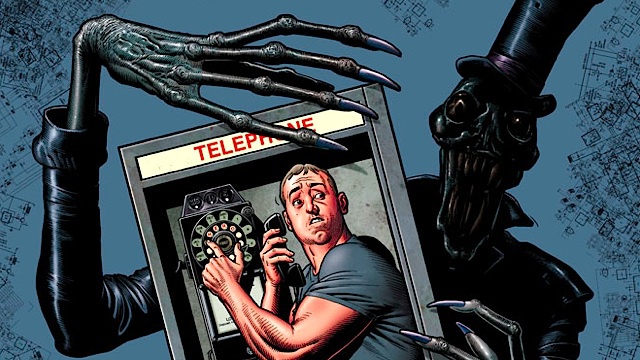Twilight is when the shadow city can best be seen and unseen, moving in and out of perception at the corners of our eyes. To see it is to see otherwise, an altervision. You may be called mad. For seeing inside and outside is a way of thinking alien to the police. As Brian Thill writes in his wonderful journal today, describing the scene in Zuccotti Park the day before the confrontations of March 17:
And this was the one thing that struck me most about the nature of the police in this twilight time, as they leaned against their cars or cracked jokes with their co-workers: “the police” is really the name for the conjunction of brute force and the absolute inability to imagine.
The twilight–my favorite time, the noir time of day, linking Baudelaire’s crépescule to The Twilight Zone, a time for imagining.
Let’s try some twilight visualizing, as an exercise in not thinking like the police–whether the disciplinary, thought, political, or what have you police.
In Walter Benjamin’s noir set in Paris, The Arcades Project, the altervisionary was the color-blind engraver and colonial explorer Charles Meryon. His city was cross-hatched, full of revolutionary shadows.
At the left, jutting into the space, is the Ministry of the Navy and the Colonies, with whom Meryon had long disputes following his service. On the ground, horsebacked troops or police, with some footsoldiers, spin in confusion. For above them, there where there should not be anything to see, is an advancing formation of marine creatures.It is a work of artistic revolt–the engraving, like the marine painting, was considered a “minor” genre, irrelevant to the grand work of History painting.
The scene is also one of memory work–the Ministry abuts the Place de la Révolution, where the guillotine had done its work. Renamed the Place de la Concorde by the Directory in 1795, it was colonized by Napoleon with the placement of an Egyptian obelisk that he had removed from Luxor. There’s another one in Central Park. In 1858 the Ministry of Navy and Colonies had begun the French colonial venture into Vietnam with what they called the Cochinchina War, leading to the establishment of a fully-fledged colony in 1864 with its capital in Saigon. We know how that turned out.
Meryon’s liminal engraving with its deep cross-hatched shadows visualized the intersection of empire and revolution with its sky-borne multitude, not quite real and yet clearly visible to the ground-bound police. Shortly after he completed this piece, he was interred in the Charenton, a notorious “asylum” for the insane.” He was released only to die.
Cross-hatch a bit further: the Ministry of the Navy was the Kreigsmarine under the German Occupation. I remember standing in the Place in 1984 at an anti-racism rally where a group of outraged French Resistance veterans pointed out the former Gestapo headquarters right next door to the Ministry. One of them was Stéphane Hessel, whose manifesto Indignez-Vous! [Get Mad!] (2010) was a formative influence in the Indignés movement that prefigured Occupy. In short, that’s us, up in the sky in the Meryon.
Cross-hatching was a term adopted by the novelist China Miéville for his noir/science fantasy The City and the City. Two cities co-exist in the same topographical space. Some spaces are total (in one city only), while many others are cross-hatched–partly in one, partly in the other. Citizens learn to negotiate this space by “unseeing,” a willed avoidance of attention.To fail to observe the divide is to “breach,” entailing catastrophic intervention by a mysterious uber-police known only as Breach.
Miéville insists that his work is not an allegory and we’re coming to understand why. Reviewing the book a year ago, Henry Farrell pointed out in the Boston Review:
Middle-class Americans and Europeans commonly unsee the homeless who are around them, affecting not to perceive them except as physical impediments to be circumnavigated. The homeless are recognized by their clothes, their gait, their way of being in the world, and in that act of recognition are dismissed.
Change “homeless” to “Occupy” and we have a good assessment of how the mainstream media and citizenry are dealing with the movement by “unseeing” it. If we stir, it is as a “remnant,” a twilight manifestation that is not quite real and should be avoided for fear of “breach.”
China Miéville is now working on a revived 1960s DC comic, Dial H for Hero. In the original comic, anyone who dialed H-E-R-O on the special phone would become a hero. For visualization, this is no ordinary word. Generals began visualizing battlefields in the late eighteenth century and then the idea was (as it were) generalized to “heroes,” Thomas Carlyle’s own fantasy about all-powerful autocrats who alone could “visualize” history (his word). The concepts that leaders have “vision” and that “great men make history” are still central to mainstream notions of authority. Carlyle argued that the modern hero Napoleon first demonstrated his visuality when he turned his artillery on the revolutionary crowd in Paris in 1795. Bloomberg, Kelly and their ilk likewise imagine themselves to be heroes.
In the new twilight of Miéville’s version of the comic, the heroes are just as hostile to the citizenry as Carlyle’s monstrous autocrats. The background of this image seems to be a cross-hatching of psychogeographies, the Situationist way of attaching feeling to space.
Don’t Dial H for Hero. There are none waiting in the shadows. It is us who wait there, unseeing, learning now to unsee our unseeing, and finding that we don’t recognize the twilight zone we have emerged into.


